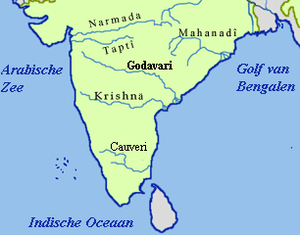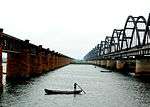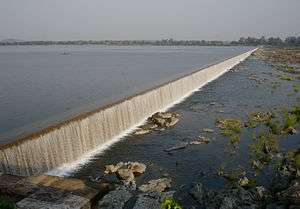East Godavari district
| East Godavari district | |
|---|---|
| District of Andhra Pradesh | |
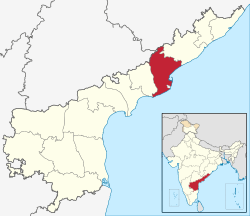 Location of East Godavari district in Andhra Pradesh | |
| Country | India |
| State | Andhra Pradesh |
| Administrative division | East Godavari district |
| Headquarters | Kakinada |
| Tehsils | 64[1] |
| Government | |
| • District collector | Kartikeya Misra IAS |
| • Lok Sabha constituencies | Kakinada, Amalapuram, Rajahmundry |
| • Assembly seats | 19 |
| Area | |
| • Total | 12,805 km2 (4,944 sq mi) |
| Population (2011) | |
| • Total | 5,151,549[2] |
| • Urban | 25.52% |
| Demographics | |
| • Literacy | 71.35% |
| • Sex ratio | 1005 |
| Vehicle registration | AP-05 |
| Major highways | National Highway-16 (Kolkata - Chennai) & NH-214 (between Kattipudi of East Godavari & Pamarru of Krishna) |
| Coordinates | 16°57′N 82°15′E / 16.950°N 82.250°ECoordinates: 16°57′N 82°15′E / 16.950°N 82.250°E |
| Website | Official website |
East Godavari district or Toorpu Godavari jilla is a district in Coastal Andhra region of Andhra Pradesh, India. Its district headquarters is at Kakinada. As of Census 2011, it became the most populous district of the state with a population of 5,151,549.[2] Rajahmundry and Kakinada are the two largest cities in the Godavari districts in terms of population.
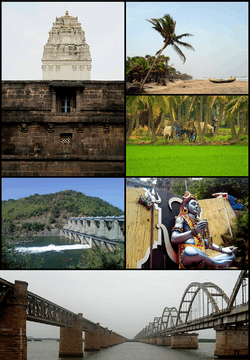
The district of Rajahmundry (present name Rajamahendravaram) was reorganised in 1859 into two districts of Godavari and Krishna. Godavari District was further bifurcated into East and West Godavari districts in 1925.[3][4] After Nov 1956's Andhra Pradesh was formed by combining parts of Naizam, Ceded and Circars, in 1959, the Bhadrachalam revenue division, consisting of Bhadrachalam and Naguru Taluqs (2 Taluqas in 1959 but later subdivided into Wajedu, Venkatapruram, Charla, Dummugudem, Bhadrachalam, Nellipaka, Chinturu, Kunavaram, and Vara Rama Chandra Puram mandals) of East Godavari district were merged into the Khammam district.[5] After June 2014's reorganisation and division of Andhra Pradesh, the Mandals of Bhadrachalam (with the exception of Bhadrachalam Temple), Nellipaka, Chinturu, Kunavaram and Vara Rama Chandra Puram were re-added back to East Godavari District.[6]
Buddhist shrines in district
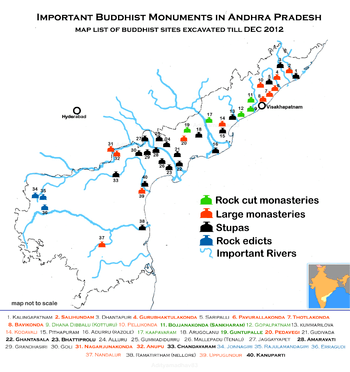
Early kingdoms
The district, like the rest of the Deccan was under the Nandas and Mauryas in its early history. After the fall of the Mauryan Empire, the district was under the Satavahanas until the 3rd century under the famous poet king Haala. Coins found during excavations have revealed the rule of Gautamiputra Satakarni, Vaasisthi-puttra Pulumaavi and Yajna Sri Satakarni. Gupta emperor Samudragupta invaded during the rule of both Pishtapura and Avamukta in the district in 350 A.D. Samudragupta's invasion was followed by the rule of the Mathara dynasty from 375 to 500. The earliest known ruler of the dynasty was Saktivarman.
The district passed into the hands of Vishnukundinas during the rule of Vikramendra Varma I during the 5th century. The records indicate that their domain extended over Visakhapatnam, West Godavari, Krishna and Guntur Districts in addition to East Godavari District. Indra Bhattaraka defeated the rulers of Vasistha Kula and re-established Vihsnukundina authority, but was shortly defeated by Kalinga armies. Indra Bhattaraka was followed to the throne by a few others, including Madhava Varma III and Manchana Bhattaraka, who tried to restore their kingdom. Madhava Varma III was the last important ruler of this family.
Chalukyas and Cholas
The Pulakesi II of Badami Chalukyas and his brother Kubja Vishnu Vardhana acquired Pishtapura in the 7th century. The Eastern Chalukya dynasty, founded by Kubja Vishnu Vardhana, ruled at first form Pishtapura, then from Vengi, and later from Rajamahendravaram. Many rulers held sway over the kingdom and their history is at times largely a record of disputes over succession. Chalukya Bhima I of this dynasty built a Shiva temple at Draksha Ramam. Jata Choda Bhima of PedaKallu (Kurnool District) killed Daanaarnava of this dynasty and occupied Vengi in 973 A.D. Daanaarnava's two sons, Sakti Varma I and Vimala Aditya, fled from the kingdom and took refuge in the court of the Chola king Rajaraja Chola I. Rajaraja invaded Vengi on behalf of the sons of Daanaarnava and killed Jata Choda Bhima. Satya Raya of the Western Chalukyas of Kalyani did not like the Chola influence in Vengi and the area witnessed many wars between the Cholas and Chalukyas. After the death of Vijaya Aditya VII in 0175 A.D., the Eastern Chalukya dynasty came to an end.
Kulottunga Chola I (Rajendra Chalukya), rival of Vijay Aditya VII, fought along the sides of Cholas and established the Chalukya Cholas province. The district along with the rest of the Vengi kingdom became part of their empire. Major portions of the district were under Velanati Chodas, trustworthy chieftains to his. Rulers of this dynasty included Gonka I, Rajendra Choda I, Gonka II and Rajendra Choda II. Vikram Aditya vii of Western Chalukyas occupied this region for short period, but it was recovered by Chalukya Cholas and Velanati Chodas. Velanati chiefs also suppressed rebellions from Haihayas of Kona, Gonka II and Rudra of the Kakatiya dynasty.
Kakatiyas and Delhi Sultanate
Inscriptions at this region including the ones at Draksha Ramam in 13th century throw light on their history. Prola II of the Kakatiya dynasty declared independence from the western Chalukyas and became a subject of Chalukya Cholas. His son Rudra obtained the Godavari delta as gift from the Rajaraja II of Chalukya Cholas. Rudra's authority over the Godavari delta was challenged by the Velanadu Chodas. The Velanati king Rajendra Choda II sent an army under his minister Davana Preggada against Rudra. Rudra was succeeded by his younger brother Mahadeva who died in a conflict with the Yadavas of Devagiri. His son Ganapati succeeded to the Kakatiya throne. Ganapati defeated Kalinga armies on the north, Pandyas of Madura and Cholas with the help of Nellooru Chodas. The Kakatiya power remained undisturbed in the Godavari region throughout the reign of Ganapati and her daughter Rudrama devi. Pratapa Rudra ascended the throne in 1295 and faced many attacks from Sultans of Delhi. After his defeat by Muhammad-bin-Tughluq in 1323, the district came under the rule of the Delhi Sultanate. Muhammad-bin-Tughluq divided South India into five provinces and appointed governors.
Nayakas, Reddi, telagas(kapus) and other Kingdoms
Delhi sultans faced rebellions from the confederacy of local chiefs under the authority of Prolaya of the Musunuri Nayaks clan. The Reddis of Addanki, Koppula Telagas of Pithapuram and the Recharla Velamas of Rachakonda actively helped him. Warangal was liberated and Telugu land enjoyed freedom for fifty years. Musunuri Kapaya Nayaka appointed his relatives Toyyeti Anavota Nayaka and Mummadi Nayaka (Korukonda) as governors in Godavari region. Mummadi Nayaka married the niece of Kapaya Nayaka. Mummadi Nayaka lived till 1388. He had three sons who ruled for a period of 40 years and later they were reduced to submission by the Reddis of Kondaveedu and their principality was merged in the kingdom of Kondaveedu. Subsequently, Narasimha Deva IV of Kalinga succeeded in conquerring this region, but was repulsed by Anavota Reddi of Rajahmundry. He was succeeded by Anavema Reddi and Kumaragiri of the same dynasty.
Kumaragiri fought many wars with the Recharlas of Rachakonda and the Kalinga rulers. He sent his general Kataya Vema along with Prince Anavota to conquer the eastern region. This resulted in the annexation of a large tract in the north as far as Simhachalam. The newly acquired territory was annexed to the Reddi Kingdom and constituted into a separate province called the eastern kingdom. Prince Anavota ruled this province with Raja-Mahendra-Varam as his capital. He died a premature death around 1395 and Kataya Vema, the general and brother-in-law of Kumara Giri, was given Raja Mahendra Rajya in appreciation of the services rendered by him to the State. Kataya Vema's departure to Raja Mahendra Varam led to the seizure of the throne of Kondaveedu by force by Peda Komati Vema.
Peda Komati Vema's authority was defined by Kataya Vema. Kataya Vema was also involved in conflict with Eruva chief Annadeva Choda, who managed to occupy a large portion of the Raja Mahendra Rajya. He was, however, defeated and driven back by Kataya Vema. Later, Kataya Vema died in a battle with Anna Deva Choda. After his death, Allada Reddi placed Kataya Vemas' son Komaragiri on the throne of Rajamahendravaram and ruled the kingdom as his regent. Komarigiri died a premature death. Allada Reddi ruled this region till his death in 1420. About 1423, the Vijayanagara ruler Deva Raya II defeated Veera Bhadra, who was then ruling this kingdom and reduced it to subjection.
After the death of Kapilendra Deva Gajapati in 1466, there was a fight between his sons Hamveera Deva and Purushottama Deva for succession. Hamveera succeeded in occupying the throne with the help of Bahmanis but he could not retain it for long. Purushottama overthrew Hamveera and tried to reconquer Rajamahendravaram and other places. But Muhammad Shah III led the forces to Rajahmundry. This battle, however, ended with the conclusion of peace treaty. After the death of Muhammad Shah III, Purushottama Gajapati overran the whole of the Godavari-Krishna do-ab and drove the Bahmani forces as far south as Kondaveedu. Purushottama was succeeded by his son Pratapa Rudra. The Vijayanagar monarch Krishna Deva Raya invaded his kingdom and brought Rajahmundry under subjugation. However, a treaty was concluded wherein Pratapa Rudra agreed to give his daughter in marriage to Krishna Deva Raya in return of the territory north of the Krishna conquered by Krishna Deva Raya.
Muslim Kingdoms
Taking advantage of the disturbed conditions, the Qutab Shahi ruler of Golkonda, Sultan Quli Qutab Shah, invaded the coastal region and took possession of Rajahmundry and the neighbouring kingdoms. Sultan Quli was murdered and he was succeeded to the throne by his son Jamshid Qutab Shah and then by his grand son Subhan Qutab Shah. During his reign, Ibrahim Qutab Shah had to ward off challenges from Shitab Khan and Vidyadhar. The last ruler of this dynasty was Abdul Hasan Tana Shah, who ruled from 1672 to 1687.
Aurangzeb conquered the sultanate of Golaconda in 1687, and Golaconda, including East Godavari District, became one of the twenty-two provinces of the Mughal Empire. The Nizam-ul-Mulk (viceroy of Golaconda) looked after the administration through military officers called Fauzdars. Pusapati Ananda Gajapati Raju, the new Raja of Vizianagaram, invited the French to occupy the Northern Circars. The tussle that ensued between the French and the English ended with the French losing all possessions in Northern Circars except Yanam.
Salabat Jung was subsequently deposed by his brother Nizam Ali Khan, who leased out Rajahmundry and Chicacole to Hasan Ali Khan. Lord Robert Clive, entered into negotiations with the Mughal Emperor Shah Alam, and obtained a firmana ceding the Northern Circars to the British East India Company in August 1765, but it was kept a secret until March 1766. The fort of Kondapalli was seized by the British, and General Cillaud was sent to Machilipatnam to undertake military operations, if necessary. The Nizam also made brisk preparations for war. War was prevented by the signing of a treaty on 12 November 1766 by which the Company, in return for occupying the Circars, undertook to maintain troops for the Nizam's assistance.
British rule, 1768–1947
By a second treaty, signed on 1 March 1768 the Nizam acknowledged the validity of Shah Alam's grant and resigned the Circars to the Company, receiving as a mark of friendship an annuity of 50,000. Finally, in 1823, the claims of the Nizam over the Northern Circars were bought outright by the Company, and they became a British possession. The Circars were incorporated into Madras Presidency, and Godavari District was constituted, which included present-day East Godavari and West Godavari districts.
Post Independence
After India's independence in 1947, the former Madras Presidency of British India became India's Madras State. In 1953, the northern districts of Madras state, including Godavari District, became the new state of Andhra. Yanam was relinquished by the French in 1954, but one condition of the cession treaty was the retention of the district's separate and distinct identity, which also applied to the other South Indian enclaves constituting today's Puducherry state.
Geography and climate
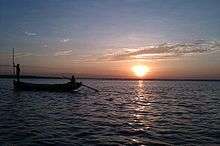

East Godavari district occupies an area of 12,805 square kilometres (4,944 sq mi),[7] comparatively equivalent to Indonesia's Sumba Island.[8] The district is bounded on north by Visakhapatnam District, Malkangiri District of Orissa on the northwest by Khammam District, on the east and south by the Bay of Bengal and on the west by West Godavari District. It has a coastline of 144 km (89 mi).[9] The small enclave (12 sq mi (30 km2)) of the Yanam district of Puducherry state lies within this district.
Demographics
According to the 2011 census East Godavari district has a population of 5,154,296.[10] This gives it a ranking of 19th in India (out of a total of 640 districts) and 1st in the state.[10] The district has a population density of 477 inhabitants per square kilometre (1,240/sq mi). Its population growth rate over the decade 2001–2011 was 5.1%. East Godavari has a sex ratio of 1005 females for every 1000 males, and a literacy rate of 71.35%.[10]
East Godavari district has a total population of 51,51,549; 25,69,419 and 25,82,130 male and female respectively. There was change of 5.10 percent in the population compared to population as per 2001 census. The census data states a density of 477 in 2011 compared to 454 in 2001.[11] Average literacy rate of East Godavari in 2011 was 71.35% compared to 65.48% in 2001. On a gender basis, male and female literacy was 74.91% and 67.82% respectively. With regards to sex ratio in East Godavari, it stood at 1005 per 1000 males compared to the 2001 census figure of 993. The average national sex ratio in India is 940 as per the 2011 census.
There were total 4,92,446 children under the age of 0-6 against 6,13,490 of 2001 census. Of total 492,446 male and female were 2,50,086 and 2,42,360 respectively. The child sex ratio as per census 2011 was 969 compared to 978 in 2001. In 2011, children under 0-6 formed 9.56% of East Godavari district compared to 12.52% in 2001.
Household indicators
In 2007–2008 the International Institute for Population Sciences interviewed 1019 households in 38 villages across the district.[12] They found that 92.5% had access to electricity, 96.7% had drinking water, 50.4% toilet facilities, and 30.9% lived in a pucca (permanent) home.[12] 28.6% of girls wed before the legal age of 18 and 79% of interviewees carried a BPL card.[12]
Divisions
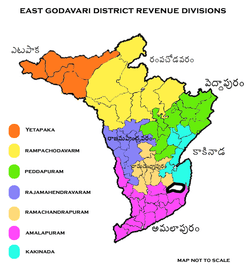
The district has 7 revenue divisions namely, Amalapuram, Etapaka, Kakinada, Peddapuram, Rajahmundry, Ramachandrapuram and Rampachodavaram with 65 mandals.[13][14][15] These 59 mandals consists of 1,374 villages, 2 municipal corporation, 7 municipalities and 10 census towns. It is the one of the two districts, alongside Chittoor district to possess two municipal corporations namely, Kakinada and Rajahmundry. The 7 municipalities in the district include, Amalapuram, Mandapeta, Peddapuram, Pithapuram, Ramachandrapuram, Samalkota, Tuni. After the merger of Dowleswaram, Hukumpeta and Katheru into Rajahmundry Municipal Corporation, there exists 7 census towns of Arempudi, Bandarulanka, Chidiga, Morampudi, Ramanayyapeta, Rampachodavaram, Suryaraopeta.[16]
Mandals
The mandals of Chinturu, Kunavaram, Nellipaka and Vararamchandrapuram were added to East Godavari district based on Polavaram ordinace.[17][18]
The list of 64 mandals in East Godavari district under 7 revenue divisions are listed in the following table:[16]
Culture
The culture of East Godavari district is a rich traditional one in all parts of the district, and reflects the true culture of Andhra Pradesh. It is known for Veda-pandits, the Godavari River and the hospitality of the people. The Telugu language originated in this district (in Rajahmundry or Rajamahendri). East Godavari District has produced several stalwarts in area of culture, music, art and cinema. Poet and writer Devulapalli Krishnasastri, musician and singer M. Balamuralikrishna (Mangalampalli Balamurali Krishna), P. B. Sreenivas, Adurthi Subba Rao, C. Pullaiah, painter N. V. Reddi Naidu, actress Jaya Prada belong to this district. Freedom fighter, social worker and politician Durgabai Deshmukh[20]
Economy
The Gross District Domestic Product (GDDP) of East Godavari is ₹52,294 crore (US$7.3 billion) and it contributes 10% to the Gross State Domestic Product (GSDP). For the FY 2013–14, the per capita income at current prices was ₹78,255 (US$1,100). The primary, secondary and tertiary sectors of the district contribute ₹16,093 crore (US$2.2 billion), ₹10,857 crore (US$1.5 billion) and ₹25,343 crore (US$3.5 billion) respectively.[9] The major products contributing to the GVA of the district from agriculture and allied services are, paddy, sugarcane, betel leaves, coconut, milk, meat and fisheries. The GVA to the industrial and service sector is contributed from construction, electricity, manufacturing, unorganised trade and transport.[9]
Transport
The total of core road network of the district is 1,274.067 km (791.669 mi). It includes, 613.289 km (381.080 mi) of existing and a proposed length of 660.780 km (410.590 mi).[21] The total rail network of the district is 171.34 km (106.47 mi).[9]
The National Highway 5 connecting Chennai and Howrah passes through this district. Rajahmundry, Tuni and Samalkot are the railway junctions in the district. The Chennai to Howrah rail line also passes through this district.
Education
The primary and secondary school education is imparted by government, aided and private schools, under the School Education Department of the state.[22][23] As per the school information report for the academic year 2015-16, there are a total of 5,986 schools. They include, 29 government, 3,452 mandal and zilla parishads, 1 residential, 1688 private, 2 model, 12 Kasturba Gandhi Balika Vidyalaya (KGBV), 285 municipal and 517 other types of schools.[24] The total number of students enrolled in primary, upper primary and high schools of the district are 722,123.[25]
District has universities located at Rajahmundry City such as Adikavi Nannaya University Rajahmundry, Telugu University, Acharya NG Ranga Agricultural University. There are numerous educational institutes with Jawaharlal Nehru Technological University, Kakinada, District Institute of Education and Training (DIET) in Rajahmundry, established in 1989 for the benefit of teacher trainees and in-service teachers. There are many educational institutions that provide education in different fields such as Engineering, Medical, Law, Pharmacy, Polytechnic and Postgraduate colleges etc. Some of the notable universities, colleges are Rangaraya Medical College in Kakinada and Govt Pithapuram Rajah College, Kakinada.
Tourism
East Godavari has many visiting places such as Historical Temples, Natural beauty and Nurseries etc. The historical temples are located at Someswaram,Amalapuram, Annavaram, Antarvedi, Draksharamam, Kotipalli, Pithapuram, Rajahmundry, Samalkota etc. It is also widely believed that most of people’s wishes come true after visiting Lord Shiva temple in Someswaram.In these temples, most of the temples having "Swayam Bhu" status of the lords and having their own "Sthala Purana (history of the place)".
Corangi Wildlife Sanctuary is located about 15 km from Kakinada on Kakinada–Yanam Road. Kadiyapu lanka, 20 km from Rajamahendravaram, is the location of many plant nurseries. Other attractions are Sir Arthur Cotton Museum at Dhavaleswaram, Coringa Wildlife Sanctuary. Eco tourism projects are located at Maredumilli, Papikondalu Rampa and Tuni Talupulamma lova is most popular temple in East Godavari district[26]
See also
References
- ↑ "District - East Godavari". Andhra Pradesh Online Portal. Retrieved 23 August 2014.
- 1 2 "East Godavari district profile". Andhra Pradesh State Portal.
- ↑ "District Profile". East Godavari District Webportal. National Informatics Centre. Retrieved 8 May 2015.
- ↑ David M. Knipe (2015). Vedic Voices: Intimate Narratives of a Living Andhra Tradition. Oxford University Press. Retrieved 8 May 2015.
- ↑ "Telangana". google.com.
- ↑ "Post division, who will get Bhadrachalam?". The Times of India.
- ↑ Srivastava, Dayawanti et al. (ed.) (2010). "States and Union Territories: Andhra Pradesh: Government". India 2010: A Reference Annual (54th ed.). New Delhi, India: Additional Director General, Publications Division, Ministry of Information and Broadcasting (India), Government of India. pp. 1111–1112. ISBN 978-81-230-1617-7.
- ↑ "Island Directory Tables: Islands by Land Area". United Nations Environment Program. 18 February 1998. Retrieved 11 October 2011.
Sumba 10,711
- 1 2 3 4 "Economy of East Godavari District". Andhra Pradesh Economic Development Board. Retrieved 25 April 2017.
- 1 2 3 "District Census 2011". Census2011.co.in. 2011. Retrieved 30 September 2011.
- ↑ "Indian Districts by Population, Growth Rate, Sex Ratio 2011 Census". Census2011.co.in. Retrieved 25 August 2012.
- 1 2 3 "District Level Household and Facility Survey (DLHS-3), 2007-08: India. Andhra Pradesh" (PDF). International Institute for Population Sciences and Ministry of Health and Family Welfare. 2010. Retrieved 3 October 2011.
- ↑ "Mandal wise population". Official website of East Godavari District. Retrieved 3 September 2015.
- 1 2 Staff Reporter. "East Godavari district gets new revenue division". The Hindu.
- ↑ "Ten new revenue divisions created". The Hindu. Hyderabad. 4 April 2013. Retrieved 31 October 2014.
- 1 2 "District Census Handbook - East Godavari" (PDF). Census of India. pp. 16–17, 54. Archived from the original (PDF) on 13 November 2015. Retrieved 18 January 2015.
- ↑ "Ordinance on Polavaram project promulgated". The Hans India. Hyderabad. 29 May 2014. Retrieved 12 November 2015.
- ↑ "The Andhra Pradesh Reorganisation (Amendment) Act, 2014" (PDF). India code. Ministry of Law and Justice, Legislative Department. 17 July 2014. Retrieved 12 November 2015.
- ↑ Murali Sankar, K.N. (4 April 2013). "All set for creation of new revenue division". The Hindu. Kakinada. Retrieved 3 September 2015.
- ↑ http://www.thehindu.com/children/she-blazed-a-trail/article17892868.ece
- ↑ ":: APRDC ::". Andhra Pradesh Road Development Corporation. Roads and Buildings Department. Retrieved 9 November 2016.
- ↑ "School Education Department" (PDF). School Education Department, Government of Andhra Pradesh. Archived from the original (PDF) on 27 December 2015. Retrieved 7 November 2016.
- ↑ "The Department of School Education – Official AP State Government Portal". www.ap.gov.in. Archived from the original on 7 November 2016. Retrieved 7 November 2016.
- ↑ "School Information Report". Commissionerate of School Education. Government of Andhra Pradesh. Retrieved 8 November 2016.
- ↑ "Student Information Report". Commissionerate of School Education. Child info 2015–16, District School Education – Andhra Pradesh. Retrieved 8 November 2016.
- ↑ "Tourist Places". East Godavari District Webportal. Retrieved 16 July 2014.
External links
| Wikimedia Commons has media related to East Godavari district. |
